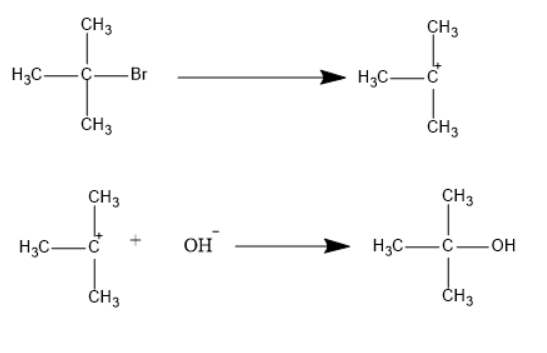
Answer
363.3k+ views
Hint: Alkyl halides are the chemical compounds that are consisting of alkyl groups bonded to the halogen atom. Due to the polarity halogen group can be displaced by the nucleophiles like hydroxide and undergoes a nucleophilic substitution which are of two types namely unimolecular and bi-molecular substitution reactions.
Complete answer:
Halogen atoms are fluorine, chlorine, bromine, and iodine. These are non-metals and has high electronegativity values. When alkyl groups are bonded with these halogens. The compounds were named as alkyl halides.
Due to the difference in the electronegativity and polarity between the alkyl groups and halogen atoms. Halogen atoms can be displaced by other nucleophiles like hydroxide in two ways.
One is \[S{N^1}\] which can be known as a unimolecular nucleophilic substitution reaction. It can take place in two steps. One step is generation of carbocation and the second step is attacking nucleophiles on carbocation. Tertiary alkyl halide undergoes this type of mechanism. Tertiary carbocation is more stable than secondary and primary carbocations.

Another type is \[S{N^2}\] which can be known as bimolecular nucleophilic substitution reaction. It can take place in single steps. Transition state will be formed in this reaction that leads to the inversion configuration of the product. Primary alkyl halides undergo this type of mechanism.
Note:
Mostly tertiary alkyl halides undergo unimolecular nucleophilic substitution as the tertiary carbocation is more stable. Primary alkyl halides undergo bimolecular nucleophilic substitution. Whereas secondary alkyl halides undergo both the mechanisms depending upon the conditions of chemical reaction.
Complete answer:
Halogen atoms are fluorine, chlorine, bromine, and iodine. These are non-metals and has high electronegativity values. When alkyl groups are bonded with these halogens. The compounds were named as alkyl halides.
Due to the difference in the electronegativity and polarity between the alkyl groups and halogen atoms. Halogen atoms can be displaced by other nucleophiles like hydroxide in two ways.
One is \[S{N^1}\] which can be known as a unimolecular nucleophilic substitution reaction. It can take place in two steps. One step is generation of carbocation and the second step is attacking nucleophiles on carbocation. Tertiary alkyl halide undergoes this type of mechanism. Tertiary carbocation is more stable than secondary and primary carbocations.

Another type is \[S{N^2}\] which can be known as bimolecular nucleophilic substitution reaction. It can take place in single steps. Transition state will be formed in this reaction that leads to the inversion configuration of the product. Primary alkyl halides undergo this type of mechanism.
Note:
Mostly tertiary alkyl halides undergo unimolecular nucleophilic substitution as the tertiary carbocation is more stable. Primary alkyl halides undergo bimolecular nucleophilic substitution. Whereas secondary alkyl halides undergo both the mechanisms depending upon the conditions of chemical reaction.
Recently Updated Pages
Who among the following was the religious guru of class 7 social science CBSE

what is the correct chronological order of the following class 10 social science CBSE

Which of the following was not the actual cause for class 10 social science CBSE

Which of the following statements is not correct A class 10 social science CBSE

Which of the following leaders was not present in the class 10 social science CBSE

Garampani Sanctuary is located at A Diphu Assam B Gangtok class 10 social science CBSE

Trending doubts
A rainbow has circular shape because A The earth is class 11 physics CBSE

Fill the blanks with the suitable prepositions 1 The class 9 english CBSE

Which are the Top 10 Largest Countries of the World?

How do you graph the function fx 4x class 9 maths CBSE

The Equation xxx + 2 is Satisfied when x is Equal to Class 10 Maths

Give 10 examples for herbs , shrubs , climbers , creepers

Change the following sentences into negative and interrogative class 10 english CBSE

Difference between Prokaryotic cell and Eukaryotic class 11 biology CBSE

Why is there a time difference of about 5 hours between class 10 social science CBSE




